Analysis of an Optical Lattice Methodology for Detection of Atomic Parity Nonconservation
Abstract
1. Introduction
2. Experimental Methods
2.1. Light Field Geometry
Applying the Fortson Scheme to a Large Sample on Neutral Atoms
2.2. Spectroscopic Detection Scheme
- The detection scheme must isolate the parity-violating component of the total signal.
- A plethora of systematic effects have to be confronted.
2.2.1. RF and Raman Spectroscopy
2.2.2. Isolation of the PNC Signature
3. Theoretical Methods
4. Results
4.1. Theoretical Results
4.1.1. Calculated PNC, E2 and M1 Matrix Elements and Associated Light Shifts
4.1.2. Calculated E1 Matrix Elements and Associated Light Shifts
4.2. Predicted Measured Parity Violation Signature
5. Discussion
- uncompensated linear Zeeman effect
- quadratic Zeeman effect
- uncompensated E1 light shifts
- uncompensated E2 light shifts
- polarisation/geometry
5.1. Possible Extensions
Other Elements than Cs
6. Conclusions
Author Contributions
Funding
Acknowledgments
Conflicts of Interest
Abbreviations
| SM | Standard model for elementary particle physics |
| PNC | Parity non-conservation |
| NSI | Nuclear spin independent |
| NSD | Nuclear spin independent |
| NAM | Nuclear anapole moment |
| E1 | Electric dipole moment |
| E2 | Electric quadrupole moment |
| M1 | Magnetic dipole moment |
| MOT | Magneto-optical trap |
| hfs | Hyperfine structure |
| RF | Radio-frequency |
| DHF | Dirac-Hartree-Fock |
| GTO | Gaussian type orbitals |
| RCC | Relativistic coupled-cluster |
| RCCSD | RCC with a single and double excitations approximation |
References
- Commins, E.D. Quantum Mechanics An Experimentalist’s Approach; Cambridge University Press: New York, NY, USA, 2003. [Google Scholar]
- Erler, J.; Langacker, P. Precision Constraints on Extra Fermion Generations. Phys. Rev. Lett. 2010, 105, 031801. [Google Scholar] [CrossRef]
- Lee, T.D.; Yang, C.N. Question of Parity Conservation in Weak Interactions. Phys. Rev. 1956, 104, 254. [Google Scholar] [CrossRef]
- Wu, C.S.; Ambler, E.; Hayward, R.W.; Hoppes, D.D.; Hudson, R.P. Experimental Test of Parity Conservation in Beta Decay. Phys. Rev. 1957, 105, 1413. [Google Scholar] [CrossRef]
- Gardner, S.; Haxton, W.; Holstein, B.R. A New Paradigm for Hadronic Parity Nonconservation and Its Experimental Implications. Annu. Rev. Nucl. Part. Sci. 2017, 67, 69. [Google Scholar] [CrossRef]
- Bouchiat, M.A.; Bouchiat, C.C. Weak neutral currents in atomic physics. Phys. Lett. B 1974, 48, 111. [Google Scholar] [CrossRef]
- Bouchiat, M.A.; Bouchiat, C. Parity violation in atoms. Rep. Prog. Phys. 1997, 60, 1351. [Google Scholar] [CrossRef]
- Ginges, J.S.M.; Flambaum, V.V. Violations of fundamental symmetries in atoms and tests of unification theories of elementary particles. Phys. Rep. 2004, 397, 63. [Google Scholar] [CrossRef]
- Safronova, M.S.; Budker, D.; DeMille, D.; Kimball, D.F.J.; Derevianko, A.; Clark, C.W. Search for new physics with atoms and molecules. Rev. Mod. Phys. 2018, 90, 025008. [Google Scholar] [CrossRef]
- Zel’dovich, B. Electromagnetic Interaction with Parity Violation. J. Exp. Theoret. Phys. 1957, 33, 1531. [Google Scholar]
- Flambaum, V.V.; Khriplovich, I.B. P-odd nuclear forces: A source of parity violation in atoms. J. Exp. Theor. Phys. 1980, 52, 835. [Google Scholar]
- Wood, C.S.; Bennett, S.C.; Cho, D.; Masterson, B.P.; Roberts, J.L.; Tanner, C.E.; Wieman, C.E. Measurement of Parity Nonconservation and an Anapole Moment in Cesium. Science 1997, 275, 1759. [Google Scholar] [CrossRef]
- Wilburn, W.S.; Bowman, J.D. Consistency of parity-violating pion-nucleon couplings extracted from measurements in 18F and 133Cs. Phys. Rev. C 1998, 57, 3425. [Google Scholar] [CrossRef]
- Haxton, W.C.; Wieman, C.E. Atomic parity nonconservation and nuclear anapole moments. Annu. Rev. Nucl. Part. Sci. 2001, 51, 261. [Google Scholar] [CrossRef]
- Tsigutkin, K.; Dounas-Frazer, D.; Family, A.; Stalnaker, J.E.; Yashchuk, V.V.; Budker, D. Observation of a Large Atomic Parity Violation Effect in Ytterbium. Phys. Rev. Lett. 2009, 103, 071601. [Google Scholar] [CrossRef]
- Antypas, D.; Fabricant, A.; Stalnaker, J.E.; Tsigutkin, K.; Flambaum, V.V.; Budker, D. Isotopic variation of parity violation in atomic ytterbium. Nat. Phys. 2019, 15, 120. [Google Scholar] [CrossRef]
- Kastberg, A.; Aoki, T.; Sahoo, B.K.; Sakemi, Y.; Das, B.P. Optical-lattice-based method for precise measurements of atomic parity violation. Phys. Rev. A 2019, 100, 050101. [Google Scholar] [CrossRef]
- Fortson, N. Possibility of measuring parity nonconservation with a single trapped atomic ion. Phys. Rev. Lett. 1993, 70, 2383. [Google Scholar] [CrossRef]
- Aoki, T.; Torii, Y.; Sahoo, B.K.; Das, B.P.; Harada, K.; Hayamizu, T.; Sakamoto, K.; Kawamura, H.; Inoue, T.; Uchiyama, A.; et al. Parity-nonconserving interaction-induced light shifts in the 7S1/2–6D3/2 transition of the ultracold 210Fr atoms to probe new physics beyond the standard model. Appl. Phys. B 2017, 123, 120. [Google Scholar] [CrossRef]
- Ellmann, H.; Jersblad, J.; Kastberg, A. Experiments with a 3D Double Optical Lattice. Phys. Rev. Lett. 2003, 90, 053001. [Google Scholar] [CrossRef]
- Sjölund, P.; Petra, S.J.H.; Dion, C.M.; Jonsell, S.; Nylén, M.; Sanchez-Palencia, L.; Kastberg, A. Demonstration of a Controllable Three-Dimensional Brownian Motor in Symmetric Potentials. Phys. Rev. Lett. 2006, 96, 190602. [Google Scholar] [CrossRef]
- Kawamura, Y.; Itagaki, Y.; Toyoda, K.; Namba, S. A simple optical device for generating square flat-top intensity irradiation from a gaussian laser beam. Opt. Commun. 1983, 48, 44. [Google Scholar] [CrossRef]
- Litvin, I.A.; Forbes, A. Intra–cavity flat–top beam generation. Opt. Express 2009, 17, 15891. [Google Scholar] [CrossRef]
- Hemmerich, A.; Hänsch, T.W. Two-dimesional atomic crystal bound by light. Phys. Rev. Lett. 1993, 70, 410. [Google Scholar] [CrossRef] [PubMed]
- Grynberg, G.; Robilliard, C. Cold atoms in dissipative optical lattices. Phys. Rep. 2001, 355, 335. [Google Scholar] [CrossRef]
- Greiner, M.; Bloch, I.; Mandel, O.; Hänsch, T.W.; Esslinger, T. Bose–Einstein condensates in 1D- and 2D optical lattices. Appl. Phys. B 2001, 73, 769. [Google Scholar] [CrossRef]
- Chin, C.; Leiber, V.; Vuletić, V.; Kerman, A.J.; Chu, S. Measurement of an electron’s electric dipole moment using Cs atoms trapped in optical lattices. Phys. Rev. A 2001, 63, 033401. [Google Scholar] [CrossRef]
- Kastberg, A. Structure of Multielectron Atoms; Springer Nature: Cham, Switzerland, 2020. [Google Scholar]
- DiBerardino, D.; Tanner, C.E.; Sieradzan, A. Lifetime measurements of cesium 5d2D5/2,3/2 and 11s2S1/2 states using pulsed-laser excitation. Phys. Rev. A 1998, 57, 4204. [Google Scholar] [CrossRef]
- Takamoto, M.; Takano, T.; Katori, H. Frequency comparison of optical lattice clocks beyond the Dick limit. Nat. Photonics 2011, 5, 288. [Google Scholar] [CrossRef]
- Aoki, T.; Torii, Y.; Sahoo, B.K.; Das, B.P.; Harada, K.; Hayamizu, T.; Sakamoto, K.; Kawamura, H.; Inoue, T.; Uchiyama, A.; et al. Light shifts induced by nuclear spin-dependent parity-nonconserving interactions in ultracold Fr for the detection of the nuclear anapole moment. Asian J. Phys. 2016, 25, 1247. [Google Scholar]
- Hofstadter, R.; Fechter, H.R.; McIntyre, J.A. High-Energy Electron Scattering and Nuclear Structure Determinations. Phys. Rev. 1953, 92, 978. [Google Scholar] [CrossRef]
- Angeli, I. A consistent set of nuclear rms charge radii: Properties of the radius surface R(N,Z). Atomic Data Nucl. Data Tables 2004, 87, 185. [Google Scholar] [CrossRef]
- Dirac, P.A.M. The Principles of Quantum Mechanics, 4th ed.; Oxford University Press: Oxford, UK, 1981. [Google Scholar]
- Boys, S.F. Electronic wave functions—I. A general method of calculation for the stationary states of any molecular system. Proc. R. Soc. Lond. A 1950, 200, 542. [Google Scholar]
- Khriplovich, I.B. The Principles of Quantum Mechanics; Gordon and Breach: Philadelphia, PA, USA, 1991. [Google Scholar]
- Čížek, J. On the Correlation Problem in Atomic and Molecular Systems. Calculation of Wavefunction Components in Ursell-Type Expansion Using Quantum-Field Theoretical Methods. J. Chem. Phys. 1966, 45, 4256. [Google Scholar] [CrossRef]
- Kümel, H. A Biography of the Coupled Cluster Method. In Recent Progress in Many-Body Theories; World Scientific: Singapore, 2002; p. 334. [Google Scholar]
- Lindgren, I.; Morrison, J. Atomic Many-Body Theory, 2nd ed.; Springer: Berlin, Germany, 1986. [Google Scholar]
- Sahoo, B.K.; Chaudhuri, R.; Das, B.P.; Mukherjee, D. Relativistic Coupled-Cluster Theory of Atomic Parity Nonconservation: Application to 137Ba+. Phys. Rev. Lett. 2006, 96, 163003. [Google Scholar] [CrossRef] [PubMed]
- Sahoo, B.K. Ab initio studies of electron correlation effects in the atomic parity violating amplitudes in Cs and Fr. J. Phys. B At. Mol. Opt. 2010, 43, 085005. [Google Scholar] [CrossRef]
- Sahoo, B.K.; Aoki, T.; Das, B.P.; Sakemi, Y. Enhanced spin-dependent parity-nonconservation effect in the 7s2S1/2→6d2D5/2 transition in Fr: A possibility for unambiguous detection of the nuclear anapole moment. Phys. Rev. A 2016, 93, 032520. [Google Scholar] [CrossRef]
- Roberts, B.M.; Dzuba, V.A.; Flambaum, V.V. Nuclear-spin-dependent parity nonconservation in s-d5/2 and s-d3/2 transitions. Phys. Rev. A 2014, 89, 012502. [Google Scholar] [CrossRef]
- Young, L.; Hill, W.T.; Sibener, S.J.; Price, S.D.; Tanner, C.E.; Wieman, C.E.; Leone, S.R. Precision lifetime measurements of Cs 6p 2P1/2 and 6p 2P3/2 levels by single-photon counting. Phys. Rev. A 1994, 50, 2174. [Google Scholar] [CrossRef]
- Vasilyev, A.A.; Savukov, I.M.; Safronova, M.S.; Berry, H.G. Measurement of the 6s 7p transition probabilities in atomic cesium and a revised value for the weak charge QW. Phys. Rev. A 2002, 66, 020101. [Google Scholar] [CrossRef]
- Damitz, A.; Toh, G.; Putney, E.; Tanner, C.E.; Elliott, D.S. Measurement of the radial matrix elements for the 6s2S1/2→7p2PJ transitions in cesium. Phys. Rev. A 2019, 99, 062510. [Google Scholar] [CrossRef]
- Toh, G.; Damitz, A.; Glotzbach, N.; Quirk, J.; Stevenson, I.C.; Choi, J.; Safronova, M.S.; Elliott, D.S. Electric dipole matrix elements for the 6p2PJ→7s2S1/2 transition in atomic cesium. Phys. Rev. A 2019, 99, 032504. [Google Scholar] [CrossRef]
- Bennett, S.C.; Roberts, J.L.; Wieman, C.E. Measurement of the dc Stark shift of the 6 7S transition in atomic cesium. Phys. Rev. A 1999, 59, R16. [Google Scholar] [CrossRef]
- Grimm, R.; Weidemüller, M.; Ovchinnikov, Y.B. Optical Dipole Traps for Neutral Atoms. Adv. At. Mol. Opt. Phys. 2000, 42, 95. [Google Scholar]
- Kramida, A.; Ralchenko, Y.; Reader, J.; NIST ASD Team. NIST Atomic Spectra Database (ver. 5.3). 2018. Available online: http://physics.nist.gov/asd (accessed on 17 July 2019).
- Renzoni, F.; Cartaleva, S.; Alzetta, G.; Arimondo, E. Enhanced absorption Hanle effect in the configuration of crossed laser beam and magnetic field. Phys. Rev. A 2001, 63, 065401. [Google Scholar] [CrossRef]
- Sahoo, B.K.; Das, B.P. Relativistic coupled-cluster analysis of parity nonconserving amplitudes and related properties of the 6s2 S1/2 – 5d2 D3/2;5/2 transitions in 133Cs. Mol. Phys. 2017, 115, 2765. [Google Scholar] [CrossRef]
- Steffen, A.; Alt, W.; Genske, M.; Meschede, D.; Robens, C.; Alberti, A. Note: In situ measurement of vacuum window birefringence by atomic spectroscopy. Rev. Sci. Instrum. 2013, 84, 126103. [Google Scholar] [CrossRef]
- Park, B.K.; Sushkov, A.O.; Budker, D. Precision polarimetry with real-time mitigation of optical-window birefringence. Rev. Sci. Instrum. 2008, 79, 013108. [Google Scholar] [CrossRef]
- Petsas, K.I.; Triché, C.; Guidoni, L.; Jurczak, C.; Courtois, J.Y.; Grynberg, G. Pinball atom dynamics in an antidot optical lattice. EPL 1999, 46, 18. [Google Scholar] [CrossRef]
- Petsas, K.I.; Coates, A.B.; Grynberg, G. Crystallography of optical lattices. Phys. Rev. A 1994, 50, 5173. [Google Scholar] [CrossRef]
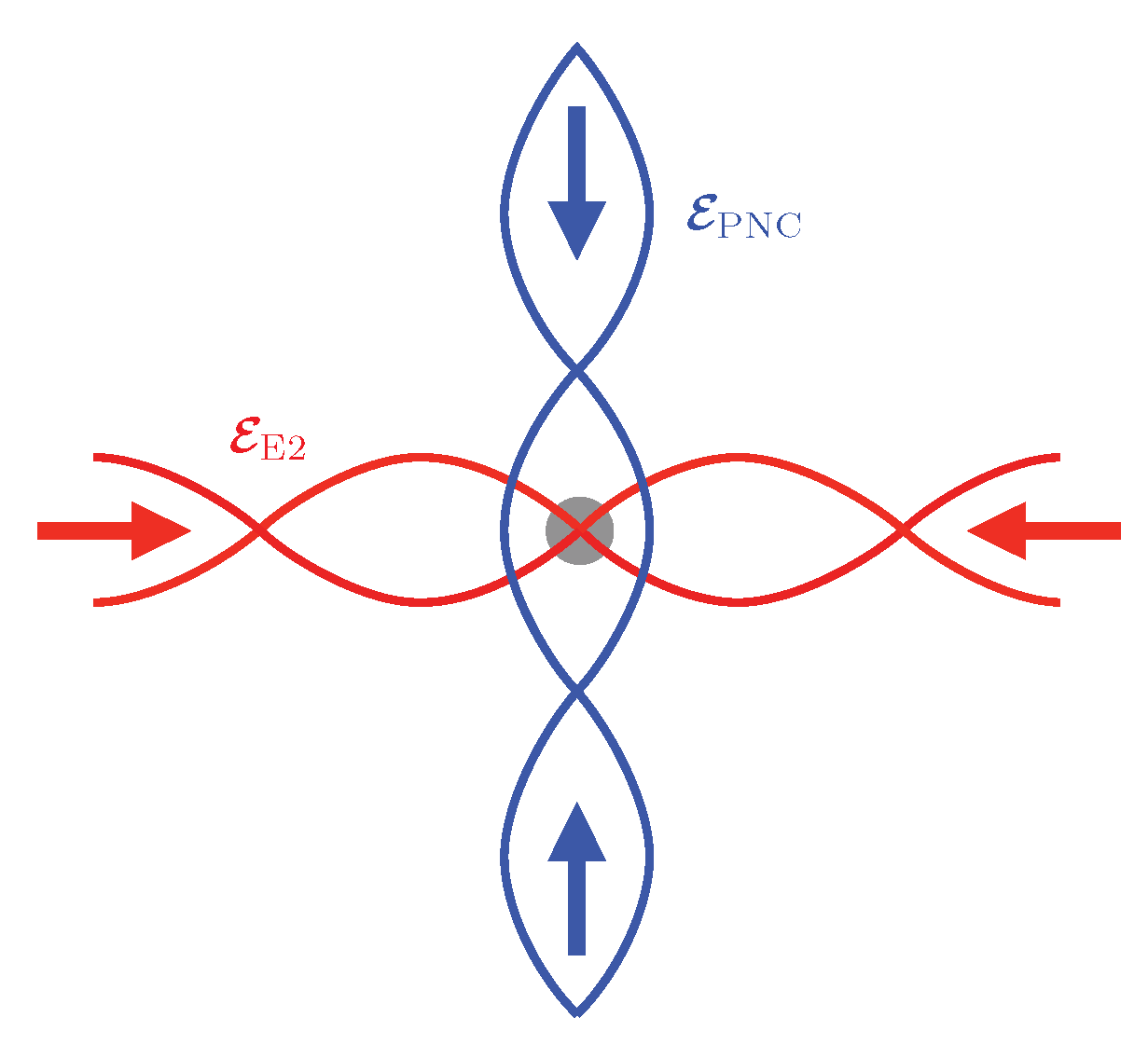
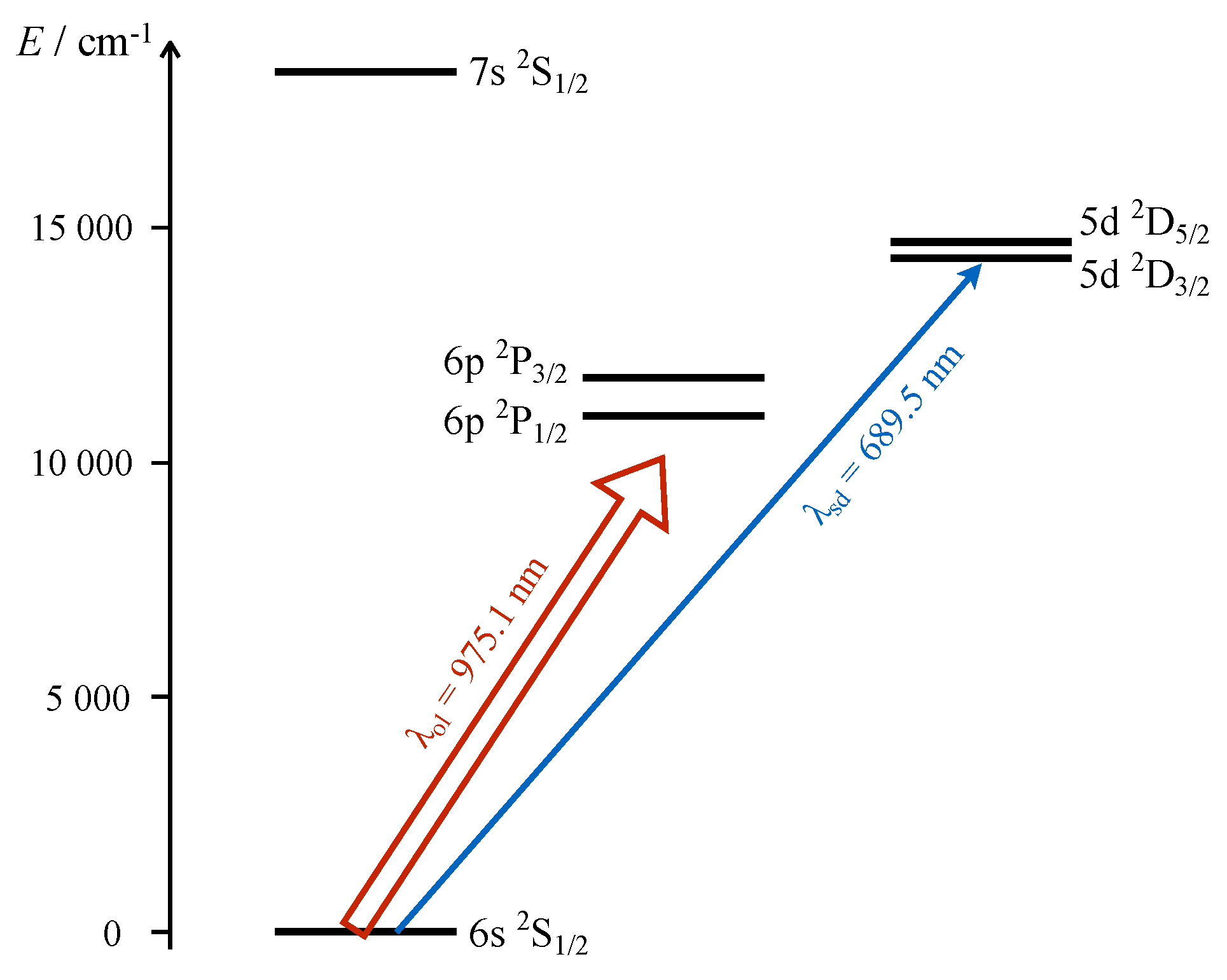
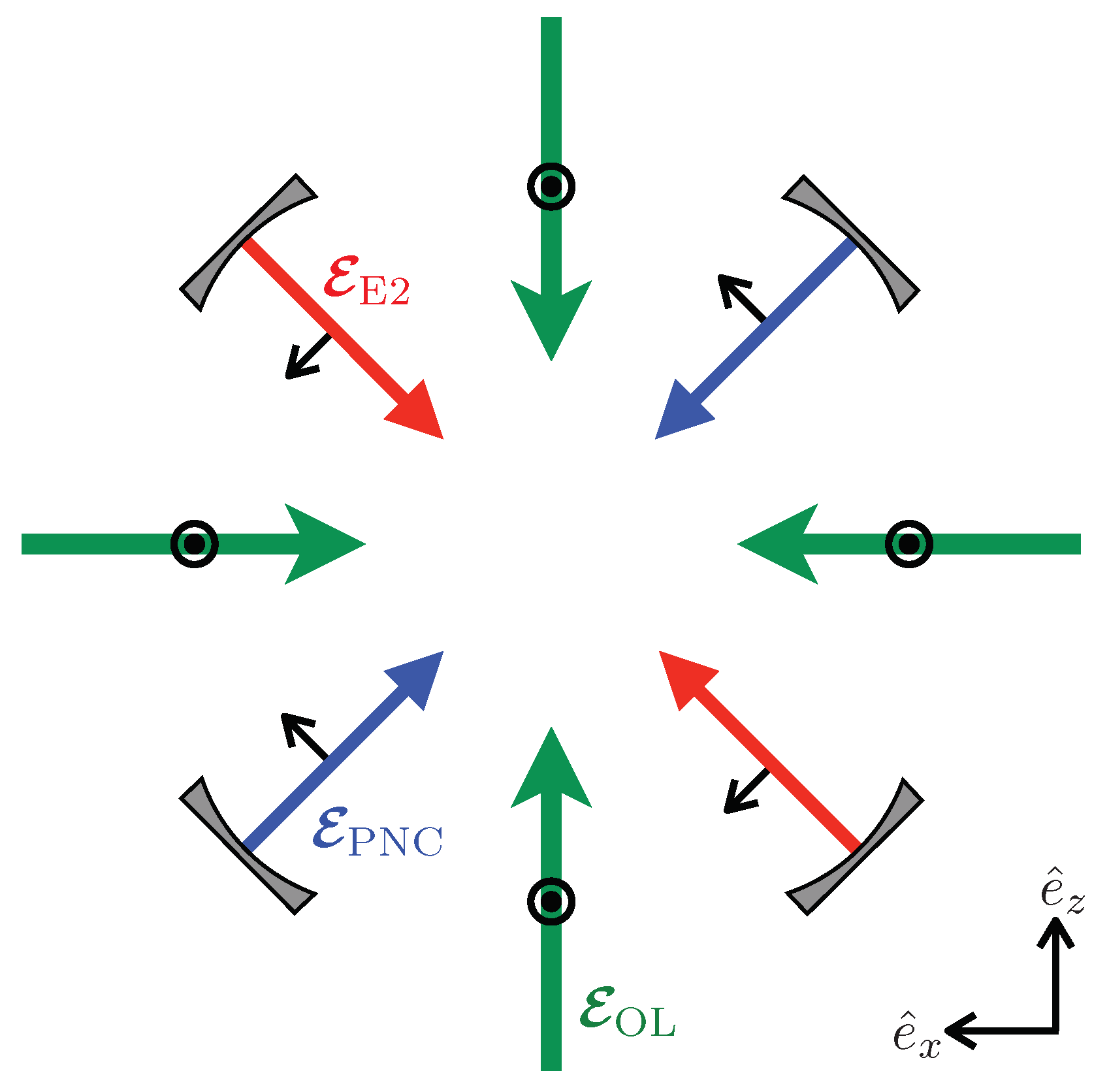
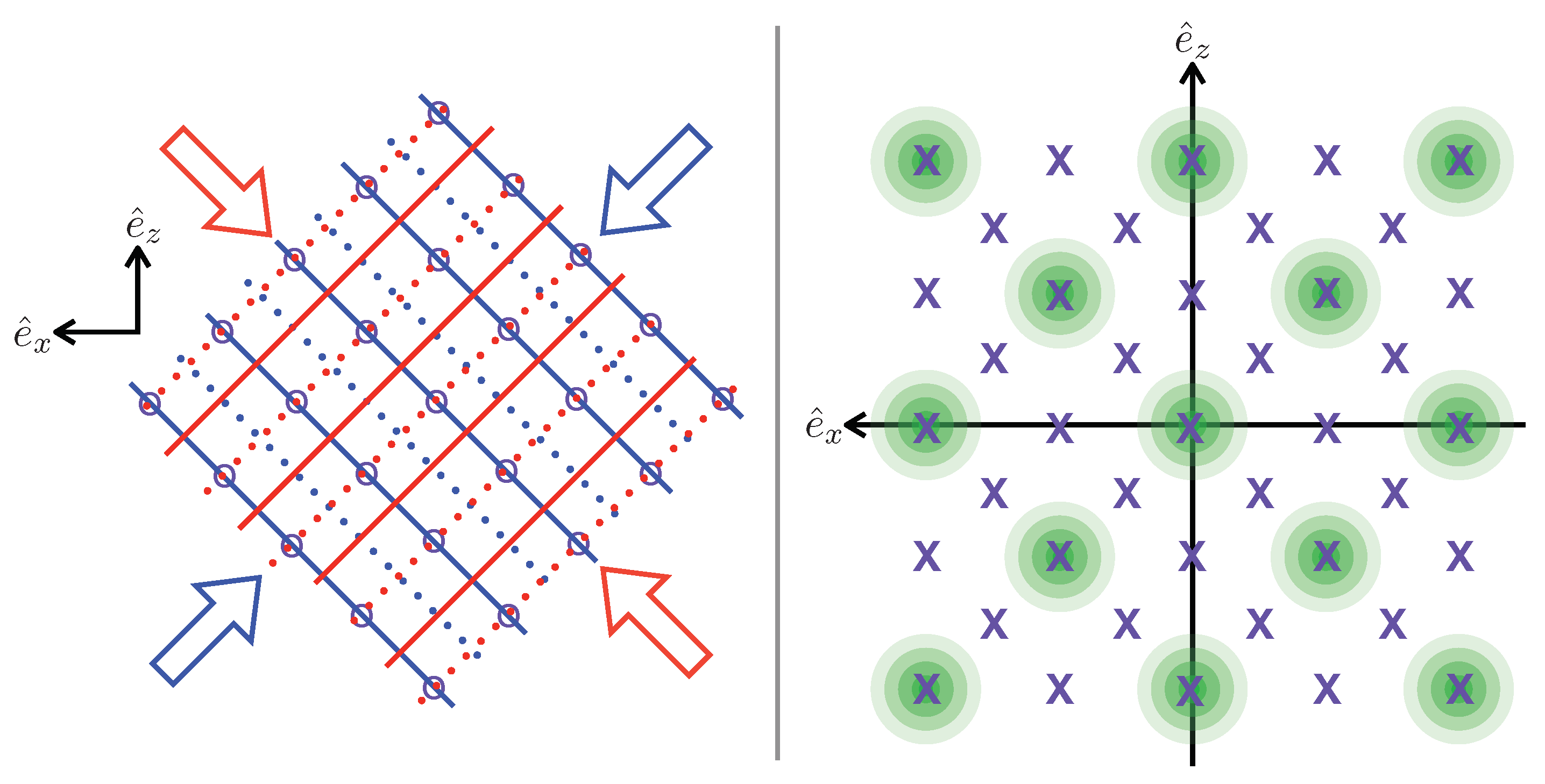
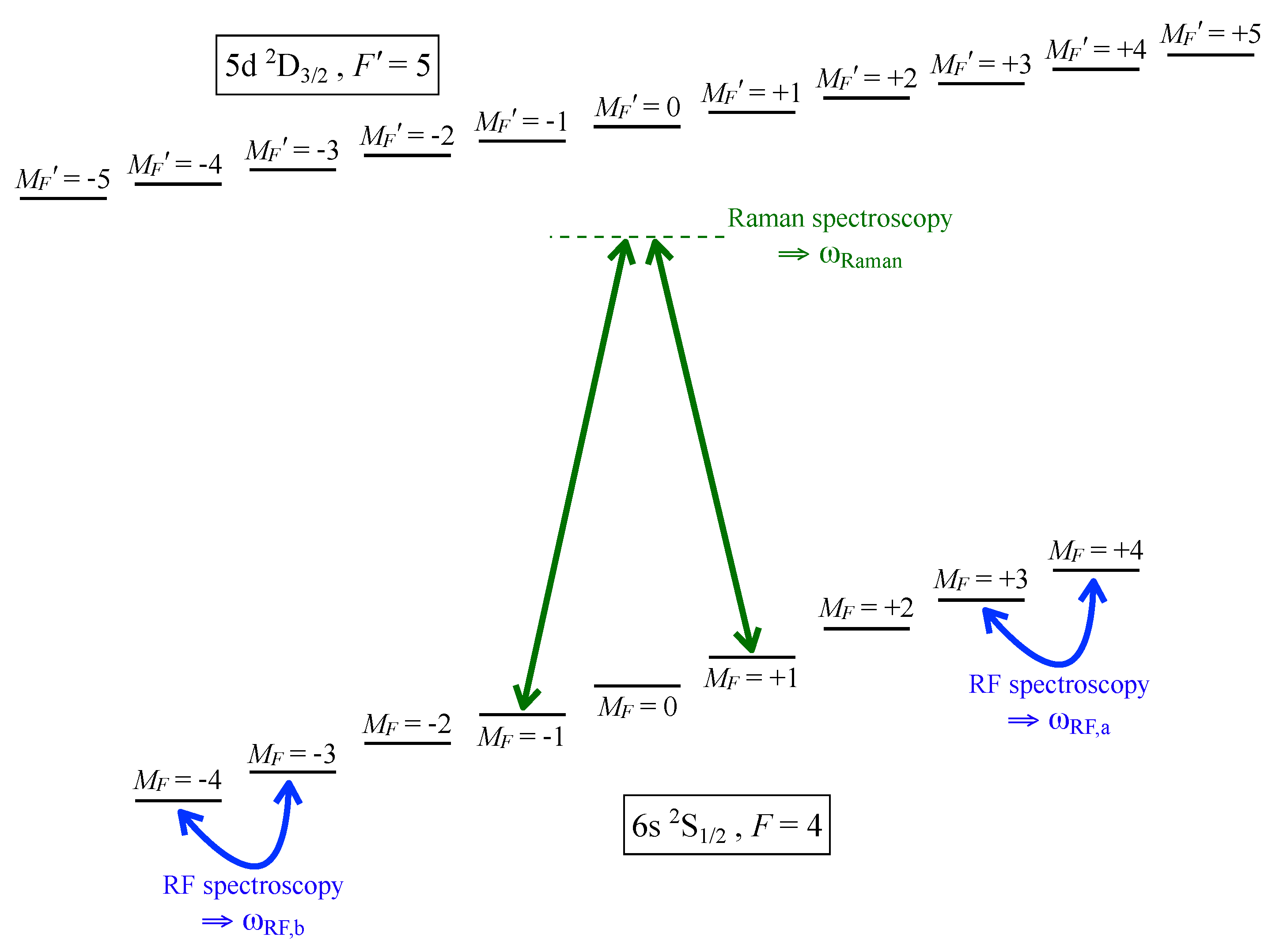

| 2.15 | 2.15 | 2.15 | 2.25 | 2.35 | 2.35 | 2.35 | |
| 40 | 39 | 38 | 37 | 36 | 35 | 33 | |
| 1–19 | 2–19 | 3–19 | 4–17 | 5–15 | 6–13 | 7–13 |
| (nm) | P (W) | w (mm) | Mode | (V/m) | |||
|---|---|---|---|---|---|---|---|
| sd-laser | 689.5 | 3 | 100 | 0.5 | flat-top | ≃ | 0.015 |
| ol-laser | 975.1 | 5 | 1 | 1.5 | Gaussian | ≃ | 0.03 |
| Method | |||
|---|---|---|---|
| DHF | ∼0 | 43.85 | 2.396 |
| RCCSD | 33.61 | 3.210 |
| – | MHz | Hz |
| – | MHz | Hz |
| – | MHz | Hz |
| Transition | DHF | RCCSD | Roberts et al. [43] | Experiment |
|---|---|---|---|---|
| 5.278 | 4.549 | 4.512 | 4.5097(74) [44] | |
| 0.372 | 0.302 | 0.2724 | 0.2825(20) [45] | |
| 0.132 | 0.092 | |||
| 0.069 | 0.040 | |||
| 7.426 | 6.397 | 6.351 | 6.3403(64) [44] | |
| 0.694 | 0.610 | 0.5659 | 0.57417(57) [46] | |
| 0.282 | 0.234 | |||
| 0.159 | 0.124 | |||
| 4.413 | 4.252 | 4.249(5) [47] | ||
| 11.012 | 10.297 | 10.308(15) [48] | ||
| 0.934 | 0.950 | |||
| 0.394 | 0.389 | |||
| 6.671 | 6.501 | 6.4890(50) [47] | ||
| 15.349 | 14.298 | |||
| 1.622 | 1.670 | |||
| 0.726 | 0.736 | |||
| 18.719 | 17.821 | |||
| 1.997 | 2.040 | |||
| 25.977 | 24.618 | |||
| 3.289 | 3.395 | |||
| 29.818 | 28.755 | |||
| 41.423 | 39.773 | |||
| 4.039 | 2.052 | |||
| 0.989 | 0.634 | |||
| 8.058 | 4.945 | |||
| 0.489 | 0.336 | |||
| 2.166 | 1.521 | |||
| 13.186 | 8.823 | |||
| 1.688 | 0.809 | |||
| 0.428 | 0.255 | |||
| 3.336 | 1.945 | |||
| 0.212 | 0.134 | |||
| 0.925 | 0.610 | |||
| 5.453 | 3.379 | |||
| 5.024 | 1.852 | |||
| 1.277 | 0.588 | |||
| 10.011 | 4.637 | |||
| 0.633 | 0.301 | |||
| 2.778 | 1.500 | |||
| 16.107 | 8.107 | |||
| 10.660 | 10.355 | |||
| 25.583 | 23.811 | |||
| 4.722 | 4.224 | |||
| 9.607 | 9.674 | |||
| 46.630 | 45.090 | |||
| 2.840 | 2.855 | |||
| 6.843 | 6.704 | |||
| 1.261 | 1.185 | |||
| 2.568 | 2.762 | |||
| 12.471 | 12.418 | |||
| 12.703 | 12.772 | |||
| 30.602 | 29.978 | |||
| 5.642 | 5.301 | |||
| 11.490 | 12.257 | |||
| 55.769 | 55.531 |
© 2020 by the authors. Licensee MDPI, Basel, Switzerland. This article is an open access article distributed under the terms and conditions of the Creative Commons Attribution (CC BY) license (http://creativecommons.org/licenses/by/4.0/).
Share and Cite
Kastberg, A.; Sahoo, B.K.; Aoki, T.; Sakemi, Y.; Das, B.P. Analysis of an Optical Lattice Methodology for Detection of Atomic Parity Nonconservation. Symmetry 2020, 12, 974. https://doi.org/10.3390/sym12060974
Kastberg A, Sahoo BK, Aoki T, Sakemi Y, Das BP. Analysis of an Optical Lattice Methodology for Detection of Atomic Parity Nonconservation. Symmetry. 2020; 12(6):974. https://doi.org/10.3390/sym12060974
Chicago/Turabian StyleKastberg, Anders, Bijaya Kumar Sahoo, Takatoshi Aoki, Yasuhiro Sakemi, and Bhanu Pratap Das. 2020. "Analysis of an Optical Lattice Methodology for Detection of Atomic Parity Nonconservation" Symmetry 12, no. 6: 974. https://doi.org/10.3390/sym12060974
APA StyleKastberg, A., Sahoo, B. K., Aoki, T., Sakemi, Y., & Das, B. P. (2020). Analysis of an Optical Lattice Methodology for Detection of Atomic Parity Nonconservation. Symmetry, 12(6), 974. https://doi.org/10.3390/sym12060974





